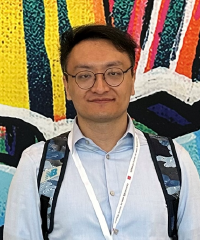Jamie Brett, M.D., Ph.D.
Haigis Lab
Sarcomas are a group of over 180 rare neoplasms of connective and metabolic tissues such as fat, muscle, bone, fibrous tissue, nerve sheaths, and blood vessels. Most sarcomas are still in need of effective therapies, despite established knowledge of genomics drivers. Sarcomas are often metabolically distinctive in histology or clinical features, such as lipid-laden liposarcomas, glycogen-storing Ewing sarcomas, or hypoglycemic solitary fibrous tumors -- but the metabolic wiring of most sarcomas is unknown. In the Haigis lab, I’m working on discovering metabolic vulnerabilities across specific sarcomas, with a current focus on well-differentiated and dedifferentiated liposarcoma. I am investigating which metabolic differences make dedifferentiated liposarcoma much more aggressive and less lipogenic compared to well-differentiated liposarcoma, and how to exploit these differences as potential new therapies.
Yutong Dai
Haigis Lab
Nicotinamide Adenine Dinucleotide (NAD+) plays a crucial role in energy metabolism, serving as a vital redox cofactor and a substrate for numerous enzymes. Research indicates a significant elevation in NAD+ levels and biosynthesis in tumor cells and a correlation between increased expressions of enzymes in the NAD+ salvage and biosynthesis pathways with decreased overall survival in cancer patients. However, the precise mechanisms through which NAD+ and its downstream metabolites influence tumor growth remain poorly understood. In the Haigis lab, my research project seeks to explore an unexplored facet of NAD+ metabolism in cancer by investigating the newly identified interactions between NAD+ metabolites and proteins. Through this project, I aim to contribute to enhance our comprehension of the interplay between NAD metabolism and other pathways, with the potential for the insights gained to pave the way for novel strategies utilizing NAD+ metabolism for cancer therapy.
Ishita Dhiman
Haigis Lab
Lung cancer is one of the leading causes of death worldwide. Advances in genomic profiling of lung tumors have enabled molecular classification of lung adenocarcinomas based on the presence of an oncogenic driver alteration. The anaplastic lymphoma kinase (ALK) gene fusion defines one such molecular subtype of non-small cell lung cancer (NSCLC), comprising 4-6% of lung adenocarcinomas. ALK fusion-positive (or “ALK+”) lung cancers are sensitive to ALK inhibition using tyrosine kinase inhibitors (TKIs). Despite the responses to ALK TKIs, patients with ALK+ lung cancer often relapse. Development of novel therapeutic approaches for TKI-resistant disease is a major unmet need. As a research assistant in the Haigis lab, I’m working on interrogating metabolic programming as a driver of resistance in ALK+ NSCLC using patient-derived models. The project highlights how metabolic pathways are rewired in the context of oncogene-driven lung cancers and may lead to novel interventions in TKI-resistant disease.
Ana Galesic, Ph.D.
Harper LabProgressive neurodegenerative disease such as Parkinson’s Disease (PD) present with debilitating disease symptoms such as tremors, rigidity, bradykinesia. Despite numerous cellular events being catalogued the molecular basis of neurodegeneration is not understood. Growing amounts of evidence from human genetic studies have implicated several autophagy-related pathways in the development of PD. While autophagy is broadly a protective mechanism that cargoes toxic material and damage organelles to the lysosomes for the degradation, selective autophagy pathways specifically recognize specific organelles and their damage or dysfunction to selectively target that organelle for degradation at the lysosome. To address open questions in the autophagy field, I have adapted the following tools: fluorescence-based reporters, biochemical enrichments, CRISPR gene editing and quantitative proteomics.
Miguel Gonzalez Lozano, Ph.D.
Harper Lab
The endolysosomal system represents the sorting station that controls trafficking, re-utilization and degradation of molecular cargo in the cell. Our understanding of the endolysosomal system and its relationship with several neurodegenerative disorders has been advanced through the identification of functional protein components that regulate the endosomal system. The aim of my postdoc is to identify and describe these molecular components by using complementary proteomic, cell biological and computational approaches. My research centers around the development and application of innovative proteomic methodologies for the high-throughput study of membrane protein interactions. These analyses allowed us to dissect several molecular mechanisms and we are now investigating their implication in membrane protein trafficking and dysregulation in neurological disorders.
Diana Ho, Ph.D.
Artavanis-Tsakonas Lab
Aggregation and mislocalization of the TDP-43 protein are hallmark cellular pathologies of amyotrophic lateral sclerosis (ALS), a devastating, fatal, and incurable neurodegenerative disease. The cellular and genetic factors that affect these processes hold immense promise as therapeutic targets for ALS and other TDP-43-related proteinopathies but remain largely unknown. Using Drosophila models of ALS, our lab has identified hundreds of potential genetic modifiers of TDP-43, including multiple components of the phospholipase D (Pld) and cAMP/PKA signaling pathways. My current work focuses on understanding the mechanisms by which these two neurologically significant signaling pathways interact with one another to regulate TDP-43 aggregation and mislocalization and affect subsequent downstream functional consequences such as motor function and survival.
Annie Hsieh, Ph.D
Haigis Lab
Gliomas are the most prevalent malignant primary brain tumors that lead to disabling neurological deficits and death. Gliomas rarely metastasize extracranially, suggesting they rely on the brain’s unique microenvironment. The striking discovery of neuron-glioma synapses indicated that glioma cells rely on neuronal inputs and glutamates signaling for proliferation. My project at the Haigis lab uses a novel approach combining rabies viral tracing with orthotopic glioma xenograft mouse models to directly visualize glioma-interacting neurons to address the location of these glioma-interacting neurons, the molecular and metabolic properties of the glioma-interacting neurons, and whether glutamate acts as signals to recruit glioma-interacting neurons. Collectively, these studies will elucidate the functions of glioma-interacting neurons and how they fuel glioma growth which can translate to therapeutic strategies for gliomas.
Songhua Hu, Ph.D
Haigis Lab
Nicotinamide adenine dinucleotide (NAD+) is an essential cofactor and substrate for hundreds of enzymes, making it central to energy metabolism. As a result, there is a huge interest in understanding how NAD+metabolism impacts disease. Sirtuins are a family of deacetylase that use NAD+ as an essential cofactor to regulate a wide range of biological processes, yet a less-appreciated aspect of sirtuin biology is the unique NAD+-derived O-acyl-ADPr byproducts generated from each deacylation cycle. This pathway is conserved from bacteria to humans, but surprisingly little is known about the function of these NAD+ byproducts in mammalian cells. As a postdoc in Haigis lab, my research focus is to understand the biological roles of these unique NAD+ byproducts in metabolism. By performing a novel proteomic-based screen assay, we found that the sirtuin-generated NAD+ byproduct may play a regulatory role in fat oxidation. These results may lead me to identify a novel metabolite signaling pathway in regulating lipid metabolism.
Hao Li, Ph.D
Rapoport Lab
Most eukaryotic proteins are degraded by the 26S proteasome after modification with a polyubiquitin chain. Substrates lacking unstructured segments cannot be degraded directly and require prior unfolding by the Cdc48 ATPase (p97 or VCP in mammals) in complex with its ubiquitin-binding partner Ufd1-Npl4 (UN). Here, we use purified yeast components to reconstitute Cdc48-dependent degradation of well-folded model substrates by the proteasome. We show that a minimal system consists of the 26S proteasome, the Cdc48-UN ATPase complex, the proteasome cofactor Rad23, and the Cdc48 cofactors Ubx5 and Shp1. Rad23 and Ubx5 stimulate polyubiquitin binding to the 26S proteasome and the Cdc48-UN complex, respectively, allowing these machines to compete for substrates before and after their unfolding. Shp1 stimulates protein unfolding by the Cdc48-UN complex, rather than substrate recruitment. In vivo experiments confirm that many proteins undergo bidirectional substrate shuttling between the 26S proteasome and Cdc48 ATPase before being degraded.
Jon Markert, Ph.D.
Farnung Lab
Nucleosomes are subject to a wide variety of different histone post-translational modifications. These different modifications give rise to various biological processes by changing the nucleosome structure and allowing for the recruitment of different chromatin binding factors. In transcription, the hallmark of an actively transcribed gene body is defined by the presence of the histone modification H3K36me3, a modification that is deposited by the enzyme SETD2. While it is well established that SETD2 function correlates with transcriptional output, it remains unclear fundamentally why. My work focuses on mechanistically and structurally characterizing SETD2 dependent H3K36me3 deposition in the presence of transcription machinery, to help understand why these two processes are biologically connected. Additionally, I am interested in understanding the downstream function of H3K36me3 deposition, and how this modification helps direct additional targets to chromatin.
Kean Hean Ooi
Gygi Lab
Many therapeutic targets implicated in major human diseases remains “undruggable". The highly disordered regions within oncogenic transcription factors or the lack of deep binding pockets in protein complexes is challenge for drug development. My work involves developing high-throughput methods for chemoproteomics screening of electrophilic fragment libraries that are able to covalently ligand a nucleophilic residue like cysteines, tyrosines, or lysines etc. In the Gygi lab, we leverage the power of TMT-based mass spectrometry to rapidly profile the human proteome for hits that would serve as starting points for medicinal chemistry optimizations. Our goal is to identify a ligand for every protein in the human proteome so that any target implicated in human disease can be provided with a therapeutic solution.
Gianmarco Rinaldi, Ph.D.
Brugge Lab
My research interest lies in identifying and characterizing the molecular mechanisms that are essential during the first steps of breast cancer formation. In particular, I focus my research on understanding the role in early tumorigenesis of two key characteristics acquired by transforming breast cancer cells: lineage plasticity and metabolic rewiring. To this end, I am applying single cell technologies, metabolomics and genetic engineering on patient-derived normal mammary organoid cultures that faithfully maintain the molecular profiles and heterogeneity of the original tissue. My goal is to describe and functionally characterize molecular mechanisms that are important during early stages of tumor formation and potentially exploit them for new therapeutic strategies.
Pushpa Sharma, Ph.D.
Van Vactor Lab
Metabolic homeostasis is a highly complex process that requires an appropriate balance between energy storage and energy expenditure in multiple organ systems. Misregulation of metabolism often results in diseases such as obesity, diabetes, cardiovascular diseases, or elevated triglycerides and cholesterol, which cause high mortality throughout the current world population. A fine balance between energy storage and mobilization is therefore essential for the metabolic well-being of an organism. My current research focuses on the regulation of metabolic processes by microRNAs using Drosophila melanogaster as a model system. microRNAs are small non-coding RNAs that act as regulators of gene expression. MicroRNA-mediated regulation offers a versatile and rapid means to control target gene expression locally and globally as per the physiological needs of an organism. My current research project has discovered a brain-specific microRNA that regulates body weight, fat storage, survival under nutrient deprivation, and longevity, by targeting a Neuropeptide precursor gene in the nervous system.
Dawafuti Sherpa, Ph.D.
Shao Lab
Cellular homeostasis relies on an intricate balance between protein synthesis and protein degradation. Numerous translational and post-translational pathways act as gatekeepers to ensure cellular balance. Among such gatekeepers are the various E3 ubiquitin ligases that play crucial roles in recognizing and eliminating misfit or superfluous co-translational or post-translational products. I am particularly interested in exploring the crosstalk between ubiquitylation and translational regulation. My goal is to understand how fundamental processes like translation are scanned for quality control and how molecular machines like E3 ubiquitin ligases modulate translational processes. Using cellular, biochemical, and structural biology tools, I aim to decipher the molecular mechanisms underlying the recognition and targeting of a variety of translational machineries and byproducts by E3 ubiquitin ligases.
Ka Yang, Ph.D.
Gygi Lab
The discovery of disease-related biomarkers that are over- or under-expressed has been facilitated by the recent progress in genomics, transcriptomics, and proteomics. These biomarkers could be potential new targets for therapy, but many of them are hard to validate or do not reveal the true origin or mechanism of diseases. The current techniques used in these fields also restrict the detection of biomarkers or pathways that involve more than expression changes, such as protein-protein interaction, enzymatic dysfunction, and immune response. Thus, there is a pressing need to create new technologies to uncover pathological factors that have escaped conventional methods. Cysteine is a key amino acid that plays a role in many essential biological functions such as oxidative stress response, formation/removal of post-translational modifications (PTMs), protein folding, and protein trafficking. In drug design and development practice, targeting reactive cysteine in protein functional domain by electrophile molecule has proven to be an effective strategy for targeting undruggable protein targets. My work concentrates on developing advanced chemoproteomic methods powered by mass spectrometry, especially affinity-based protein profiling (ABPP), to profile the proteome-wide covalent binding of nucleophilic cysteines by molecules. My colleagues and I in Gygi lab have devised chemoproteomic methods that incorporate cutting-edge technologies such as streamlined and high-throughput sample preparation, sample multiplexing, and gas-phase fractionation to enhance cysteine profiling efficiency and peptide/proteome coverage. The outcome of my research will improve our knowledge about the cysteine reactivity changes in response to disease and drugs as well as identify potential small-molecule electrophiles targeting disease-relevant cysteines.













